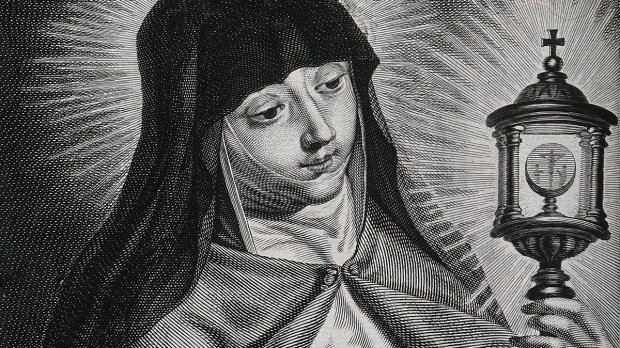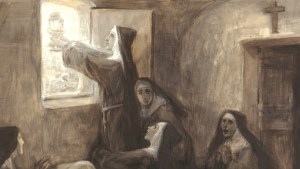While many are familiar with St. Clare of Assisi and her radical decision to pursue a life of religious poverty, few remember her intense love of the Eucharist.
St. John Paul II, on the 800th anniversary of her birth, highlighted this aspect of her life.
Due to a type of iconography which has been very popular since the 17th century, Clare is often depicted holding a monstrance. This gesture recalls, although in a more solemn posture, the humble reality of this woman who, although she was very sick, prostrated herself with the help of two sisters before the silver ciborium containing the Eucharist (cf. LegCl 21), which she had placed in front of the refectory door that the Emperor’s troops were about to storm. Clare lived on that pure Bread which, according to the custom of the time, she could receive only seven times a year. On her sickbed she embroidered corporals and sent them to the poor churches in the Spoleto valley.
The Golden Legend also mentions St. Clare’s Eucharistic devotion.
When she would receive the body of our Lord, it was marvel to see the tears that she wept, of which [her eyes were] all wet.
When instructing her own nuns, she would urge them to gaze lovingly upon the Eucharist.
Gaze upon him, consider him,
St. Clare of Assisi
contemplate him,
as you desire to imitate him
St. John Paul II went so far as to say that she lived a “Eucharistic life.”
In reality Clare’s whole life was a Eucharist because, like Francis, from her cloister she raised up a continual “thanksgiving” to God in her prayer, praise, supplication, intercession, weeping, offering and sacrifice. She accepted everything and offered it to the Father in union with the infinite “thanks” of the only-begotten Son, the Child, the Crucified, the risen One, who lives at the right hand of the Father.
For those who are inspired by her life, don’t forget her wonderful example of Eucharistic devotion.



